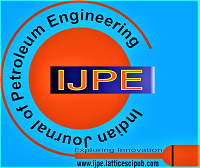![]()
An Optimal Selection of Bit Stick-Out, Running Speed and Soaking Time of Conductor Pipe Jetting in Deep Water Criteria
Mohamed Ali Amin1, Saeed Kamel2, Abdel Sattar Dahab3
1Eng. Mohamed Ali Amin, Department of Petroleum and Metallurgy, Suez University, Faculty of Petroleum & Mining Engineering, Cairo, Egypt.
2Prof. Dr. Saeed Kamel, Professor, Department of Petroleum Engineering, Suez University, Faculty of Petroleum & Mining Engineering, Suez, Egypt.
3Prof. Dr. Abdel Sattar Dahab, Professor, Department of Petroleum and Metallurgy, Suez University, Faculty of Petroleum & Mining Engineering, Cairo, Egypt.
Manuscript received on 18 September 2025 | First Revised Manuscript received on 05 October 2025 | Second Revised Manuscript received on 18 October 2025 | Manuscript Accepted on 15 November 2025 | Manuscript published on 30 November 2025 | PP: 1-11 | Volume-5 Issue-2 November 2025 | Retrieval Number: 100.1/ijpe.B192205021125 | DOI: 10.54105/ijpe.B1922.05021125
Open Access | Editorial and Publishing Policies | Cite | Zenodo | OJS | Indexing and Abstracting
© The Authors. Published by Lattice Science Publication (LSP). This is an open-access article under the CC-BY-NC-ND license (http://creativecommons.org/licenses/by-nc-nd/4.0/)
Abstract: The design and installation of conductor pipe in deepwater environments are crucial for ensuring stable soil penetration and maintaining structural integrity. This study aims to establish a comprehensive understanding of the interdependencies among key parameters—bearing capacity, soil recovery coefficient, water jet force, side friction force, and running speed—to determine optimized jetting conditions. Utilizing numerical analysis through an empirical model and optimization techniques implemented in MATLAB, this research provides insights into efficient and stable conductor installation. Our findings indicate that soil recovery is most significant within the initial 3 hours post-jetting, with diminishing returns thereafter, suggesting that optimal soaking times are critical. The study further reveals that maximizing water jet force is achieved at smaller angles of reflection, underscoring the importance of precise jet nozzle orientation for effective soil penetration. Additionally, increased weight on the bit effectively reduces side friction, leading to smoother penetration. The investigation yielded optimized jetting parameters: bit stick-out of 0.145 ft, running speed of 16.4 ft/h, and soaking time of 4 hours. These parameters are demonstrated to ensure high efficiency while minimizing operational risks. The outcomes of this research offer valuable practical knowledge for maximizing jetting operations, reducing installation duration, and enhancing overall drilling efficiency in deepwater settings. While these findings are derived from numerical simulations, they provide a robust theoretical framework for future empirical validation.
Keywords: Deepwater Drilling, Conductor Jetting, Bearing Capacity, Side Friction Force, Water Jet Force, Optimization, Offshore Drilling, Recovery Coefficient, Running Speed, Bit StickOut.
Scope of the Article: Drilling and Production
